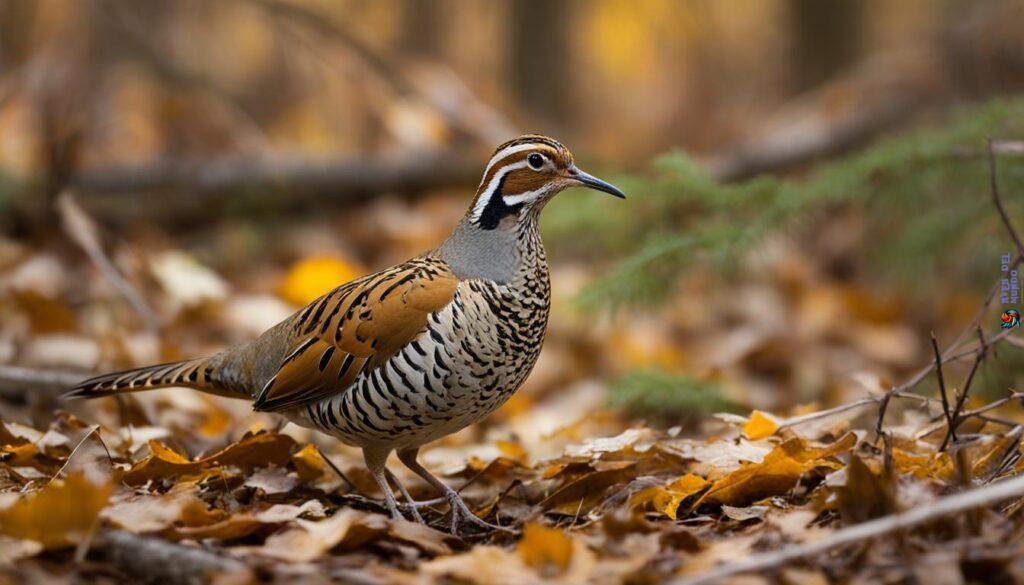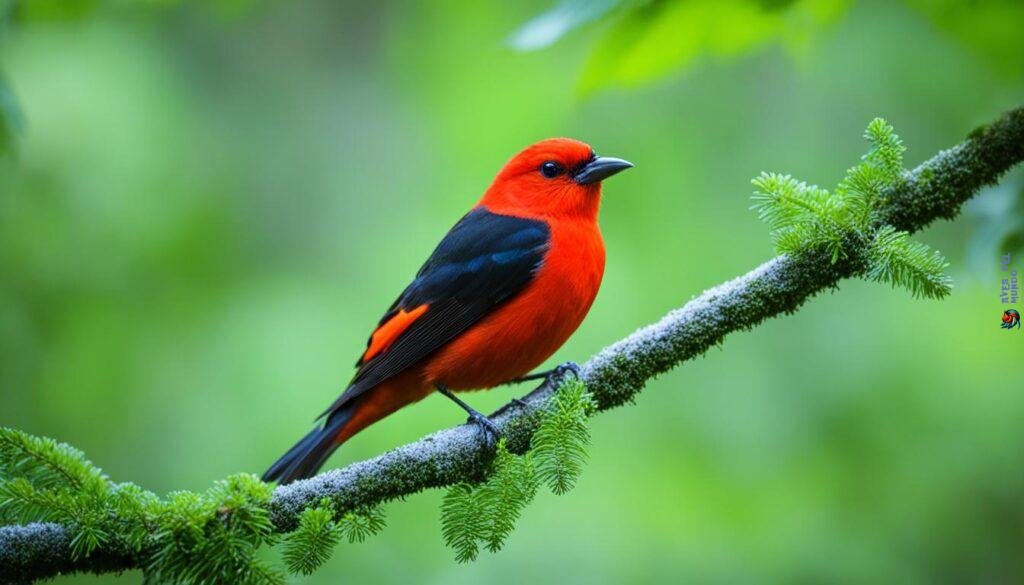Did you know that there are numerous species of orange birds with vibrant plumage, showcasing the stunning beauty of nature? From the bright oranges of the Baltimore Oriole to the warm buffy-orange of the Carolina Wren, these colorful avian species captivate birdwatchers and enthusiasts alike. In this guide, we will explore the diverse habitats and behaviors of these striking orange birds found in North America. Get ready to discover the fascinating world of these feathered wonders.
Whether you’re a devoted bird watcher or simply curious about the natural world, learning about orange birds can provide a unique insight into the diversity and intricacies of avian life. Let’s delve into the stunning world of orange birds and uncover their remarkable traits, from their distinctive orange plumage to their fascinating behaviors in their natural habitats.
Orange Birds of North America
Orange birds can be found in North America within various bird groups. Many of these birds are male species, while the females of the same species may be of a different color. Some orange bird species prefer dry open areas, while others favor mixed forests. The Baltimore Oriole, Bullock’s Oriole, and Black-headed Grosbeak are just a few examples of orange birds that can be seen in North America.

Male and Female Orange Birds
Among the orange birds of North America, there is an interesting pattern of color differentiation between males and females. While the males exhibit vibrant shades of orange, the females of the same species can have different colors in their plumage, ranging from duller orange tones to completely different hues. This phenomenon is often observed in many bird species, where the males have brighter, eye-catching plumage to attract mates and establish their territory, while the females have more cryptic coloring to blend in with their surroundings and protect their nests.
Habitat Preferences
Orange birds in North America display a wide range of habitat preferences. Some species tend to inhabit dry open areas, such as grasslands, deserts, or scrublands, where they can find suitable nesting sites and ample food sources. On the other hand, certain orange bird species thrive in mixed forests, where they can utilize the diverse vegetation and take advantage of the abundance of insects and fruits. These habitat preferences reflect the specific ecological requirements of each orange bird species and contribute to their overall distribution patterns across the continent.
| Orange Bird Species | Habitat Preference |
|---|---|
| Baltimore Oriole | Mixed forests |
| Bullock’s Oriole | Dry open areas, including riparian woodlands |
| Black-headed Grosbeak | Mixed forests, woodlands |
«The vibrant plumage of male orange birds serves as a visual signal to attract mates, while the females adopt more subtle colors for camouflage and nest protection.» – Ornithologist Jane Wilson
Orange Birds in North America: Notable Species
When it comes to orange birds in North America, several species stand out for their vibrant plumage and unique characteristics. Let’s take a closer look at some of these notable species:
American Robin
The American Robin is one of the most well-known orange birds in North America. With its distinctive orange-red breast, this bird is a familiar sight across the continent. Known for its melodious song and adaptability, the American Robin can be found in a variety of habitats, from woodlands to suburban gardens.
Carolina Wren
The Carolina Wren is a small bird with warm buffy-orange plumage. It is commonly found in the eastern and southeastern regions of the United States. Known for its vibrant song, the Carolina Wren is a delightful visitor to gardens and parks, often surprising observers with its loud and melodious voice.
Rufous Hummingbird
The Rufous Hummingbird is a tiny bird that showcases vibrant orange plumage, particularly in the male species. This remarkable bird is known for its incredible long-distance migration, traveling from its breeding grounds in the western United States and Canada to wintering grounds in Mexico and Central America.
Baltimore Oriole
The Baltimore Oriole is a migratory bird with striking orange and black plumage. It is commonly found in eastern North America during the summer months when it breeds in woodlands and gardens. Known for its exquisite song and skillful nest-weaving abilities, the Baltimore Oriole is a favorite among birdwatchers.
Orchard Oriole
The Orchard Oriole is another migratory bird that displays vibrant orange and black plumage. Found in the eastern and central regions of North America during the breeding season, this bird is often seen in orchards, open woodlands, and gardens. The Orchard Oriole’s unique appearance and distinct call make it a delight to observe.
These notable species of orange birds bring color and charm to the landscapes of North America. Whether they are singing from the treetops, building intricate nests, or embarking on incredible migrations, these birds never fail to captivate bird enthusiasts and nature lovers alike.

Orange Birds in North America: Other Notable Species
While the Baltimore Oriole, Bullock’s Oriole, and Black-headed Grosbeak are well-known orange birds in North America, there are several other species that deserve recognition. Let’s explore three more notable orange bird species:
American Woodcock
The American Woodcock, also known as the timberdoodle, is a fascinating short-legged shorebird with orange underparts. These plump birds can be found in moist forests and marshy areas across eastern North America. They have a unique behavior known as the «sky dance,» where males perform mesmerizing aerial displays during courtship.
Altamira Oriole
Primarily found in Mexico and southern Texas, the Altamira Oriole is a striking orange bird known for its intricate hanging nests. These birds exhibit partial migration, with some individuals staying in their breeding territories year-round. Their melodious, flute-like song adds to their allure and makes them a delight to observe.
Northern Cardinal
The Northern Cardinal is a beloved bird with its striking red plumage and beautiful song. Found across a wide range of habitats in North America, these birds are known for their year-round presence. The male cardinal’s vibrant orange-red feathers and distinctive crest make it a favorite visitor at bird feeders, while the female showcases a more subtle beauty with her reddish-brown plumage.
These lesser-known orange bird species, including the American Woodcock, Altamira Oriole, and Northern Cardinal, contribute to the vibrant birdlife of North America with their unique characteristics and captivating presence.

Orange Birds in North America: Conservation Concerns
The Hooded Oriole and Scarlet Tanager are two orange bird species that require special attention and conservation efforts. These birds have unique nesting habits and face threats that put their populations at risk.
The Hooded Oriole
The Hooded Oriole (Icterus cucullatus) is a beautiful orange bird with a vibrant yellow hood. It is found in southwestern parts of North America, including California, Arizona, and Mexico. This species is known for its pendulous nest, which it weaves using plant fibers hanging from palm fronds and other similar structures.
Conservation efforts for the Hooded Oriole are crucial because urbanization and habitat loss pose significant threats. Destruction of nesting areas and the removal of palm trees impact their ability to reproduce and thrive. Additionally, climate change and pesticide use may affect their food sources.
To conserve the Hooded Oriole, preserving its natural habitat, including palm groves and other suitable nesting sites, is essential. Public awareness and education programs can also play a significant role in promoting responsible practices to protect this species.
The Scarlet Tanager
The Scarlet Tanager (Piranga olivacea) is a stunning orange and black bird that nests in deciduous woodlands across North America. The male has bright scarlet plumage, while the female displays a more subtle yellow-green color. These birds undertake long-distance migrations, spending winters in South America and returning to breed in the eastern and central parts of North America.
The Scarlet Tanager faces various conservation concerns, primarily due to habitat loss and deforestation. As their preferred nesting sites, deciduous forests are cut down or fragmented for agriculture and urban development, disrupting their breeding and foraging habitats.
Protecting and restoring forested areas, implementing sustainable land management practices, and supporting initiatives that promote reforestation are essential steps in conserving the Scarlet Tanager. Additionally, raising awareness about the importance of preserving their habitats and reducing pesticide use can make a significant difference in their conservation.

Orange Birds in North America: Migration Patterns
Certain orange bird species, such as the Bullock’s Oriole, Black-throated Mango, and Flame-colored Tanager, exhibit specific migration patterns. These birds travel long distances, following flyways and stopping at suitable habitats along their journey. Migration plays a crucial role in the survival and reproduction of these orange bird species.

| Orange Bird Species | Migratory Route | Habitat |
|---|---|---|
| Bullock’s Oriole | Western United States to Mexico and Central America | Open woodlands, riparian areas |
| Black-throated Mango | Southwestern United States to Central America | Lowland tropical forests |
| Flame-colored Tanager | Central and South America to the United States | Deciduous and mixed forests |
Migration allows these orange birds to take advantage of seasonal changes in food availability and breeding opportunities. The journey is often long and perilous, requiring the birds to navigate hazards such as storms and predation. Successfully completing their migration allows these species to find suitable nesting grounds and ensure the survival of their offspring.
Interesting Facts:
- The Bullock’s Oriole can cover a distance of up to 3,000 miles during migration.
- The Black-throated Mango is a neotropical species that travels thousands of miles each year to breed and find food.
- The Flame-colored Tanager’s migration route takes it from Central and South America all the way to the United States, covering vast distances.
«Migration is an incredible feat that showcases the remarkable adaptability of these orange bird species. Their ability to navigate long distances and find suitable habitats along the way is truly awe-inspiring.»
Orange Birds in North America: Behavioral Adaptations
When it comes to orange birds in North America, species like the American Redstart, Scott’s Oriole, Audubon’s Oriole, and Yellow-breasted Chat demonstrate remarkable breeding behaviors, courtship displays, and nesting habits. These unique adaptations play a crucial role in ensuring the successful reproduction and survival of these captivating orange birds.
The American Redstart, known for its striking black and orange plumage, exhibits an intriguing behavior called «flash and sally.» During courtship, the male Redstarts flash their wings and tails, revealing vibrant orange patches, while performing acrobatic flights. This elaborate display is believed to attract females and establish territories.
As for the Scott’s Oriole and Audubon’s Oriole, both species engage in elaborate courtship rituals to attract mates. The Scott’s Oriole performs a unique «song-swapping» behavior with its partner, where they exchange tunes in a synchronized manner, creating a melodious duet. Meanwhile, the Audubon’s Oriole flies in graceful arcs, showcasing its striking orange and black plumage while producing a series of clear, whistling notes to court their potential partners.
The Yellow-breasted Chat is known for its secretive nesting habits. This bird constructs its nest in dense shrubs or tangled vegetation, carefully hidden from predators. The male Chat defends its territory by singing a distinctive and melodious song, delivering a mixture of fluty notes and harsh rattles, thus signaling its presence.



